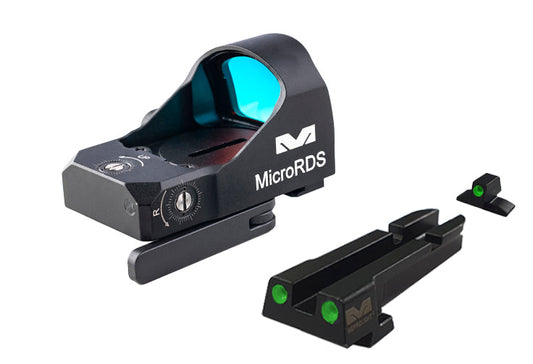

Mepro Micro RDS Reflex Sight for IWI Masada pistols offers a seamless aiming solution for handguns and provides a reliable backup for rifles at close distances. This lightweight sight enhances situational awareness with its large display window, allowing users to keep both eyes open for rapid target acquisition. The quick-release feature enables swift access to self-illuminated backup sights, making it ideal for dynamic shooting scenarios and tactical applications.
Battery changes are hassle-free, as they do not require the removal of the sight from the slide, ensuring the sight remains zeroed at all times. The adjustable aiming point brightness allows for optimal visibility in varying lighting conditions, which is crucial for performance in both low-light and bright environments.
Key Features:
- ADJUSTABLE BRIGHTNESS for optimal visibility in various lighting conditions.
- LIGHTWEIGHT DESIGN at just 37 grams, enhancing maneuverability without adding bulk.
- QUICK RELEASE ADAPTER allows for rapid attachment and detachment, ensuring versatility.
- SELF-ILLUMINATED BACKUP SIGHTS provide reliable aiming solutions in low-light situations.
- EASY BATTERY ACCESS ensures minimal downtime when changing the battery.
- DUAL ILLUMINATION OPTIONS featuring tritium for consistent visibility.
- PRECISION ZEROING KNOBS for precise horizontal and vertical adjustments.
- COMPATIBLE WITH MULTIPLE SIGHTS including Trijicon RMR and EOTech MRDS, enhancing adaptability.
Technical Specifications
| Specification | Details |
|---|---|
| Weight (Sight Only) | 37 gr. / 1.3 Oz |
| Dimensions (LxWxH) | 46 x 33 x 26 mm 1.8″ x 1.3″ x 1″ |
| Window Size | 22.5 x 17.5 mm 0.9″ x 0.7″ |
| Aiming Point Diameter | 3 / 6 MOA |
| Zeroing Knobs | Horizontal & Vertical |
| Click Size | 1 MOA |
| Reticule Brightness | 1 x Auto + 3 x Manual |
| Battery Type | 1 x CR2032 |
| Weapon Adaptor | Adjustable to Most Handguns |
| Interface | Dovetail (Backup Sight) |
| Illumination | Tritium |
| Supported Sights | Trijicon RMR, EOTech MRDS, Leopold Delta, Docter, CMORE, Vortex, Burris |
| Operation Time | 10 Years (Self-illuminated night sights) 200 hours (continuous, highest brightness) |
| Power Saving | Light sensor, Motion sensor |
What's in the Box?
- Mepro Micro RDS Reflex Sight
- Quick Release Adapter
- Backup Self-illuminated Night Sight Set
- Support Plates
Customer Reviews
"The clarity is amazing, even in low light! It's easy to adjust." - Jamie T.
"Lightweight and easy to install. Perfect for my IWI Masada." - Alex R.
"I love the quick release feature; it makes switching optics a breeze." - Chris L.
FAQ
How does the Mepro Micro RDS perform in low light? The sight features tritium illumination, which provides excellent visibility in dim conditions. Additionally, it has adjustable brightness settings to accommodate various lighting environments, ensuring it remains effective whether you're in bright sunlight or low-light scenarios.
Is the sight durable enough for tactical use? Yes, the Mepro Micro RDS is designed for rugged environments. It is waterproof and fog-proof, making it suitable for tactical applications, including law enforcement and military use. Its lightweight yet durable construction withstands the rigors of daily use.
Can I use this sight on other handguns? The sight comes with an adjustable weapon adapter that fits most handguns, allowing for versatility in your optics setup. It is also compatible with popular micro red dot sights, enhancing its adaptability across different platforms.
Similar Models
Looking for additional options? Explore our range of Meprolight sights, including the Mepro FT Bullseye for enhanced target engagement and the Mepro M21 for a self-powered solution. Discover the complete collection of tactical optics tailored to meet your shooting needs.
You May Also Like
Here’s some of our most similar products people are buying. Click to discover trending style.






